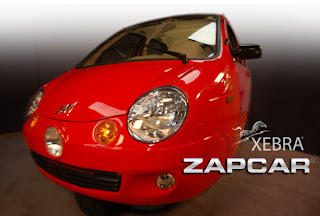"NEV" stands for "Neighborhood Electric Vehicle". NEV's are a relatively new class of electric vehicle that evolved out of golf carts. They are street legal but are restricted by the National Highway Traffic Safety Administration to run under 25 mph, though many states allow them to drive up to 35 mph. Below is a picture of an example NEV, the
Zap Xebra:
The specs on this car are:
- Speed: up to 40 mph
- Range: Up to 25 miles per charge
- Cost: around $12,000 before taxes
- Battery: Lead Acid
The idea behind NEVs is that many people do most of their driving around town for which they don't need a full sized ICE vehicle or even a hybrid/plug-in hybrid. In that kind of situation, the range and speed limitations don't mean as much.
Bruce England, a colleague who I met through some work we both did for the local city-sponsored sustainability effort, bought one in 2008 (he reports about it
here). He uses his Xebra about 99% of the time and really loves the car. But there are many drawbacks. The only safety feature of the car is a seatbelt (and see
here for what may happen in a crash, even at low speed). Bruce doesn't seem to find the range restriction such a problem, though, for me, it would be just on the border of what I could use for a daily commute if I were not going anywhere else during the day. Battery maintainability is an issue even with lead acid batteries, and Bruce recommends a couple of after market battery maintenance devices, since the Xebra does not come with one. Lithium batteries absolutely require a sophisticated battery maintenance system or else they can be easily ruined by overcharging, which of course makes them even more expensive but more robust. Lead acid batteries can last up to 10 years depending on how they are used, but they can also quickly expire after 3. Replacing batteries can be expensive and easily negate the cost advantages of electric over ICE. Bruce also has a list of creature comforts and fit-and-finish features that are taken for granted in cars from larger manufactures, but are missing in the Xebra.
The main issue with NEVs is that they are a low volume product so they are much more expensive than a mass market car, independent of their electric drive. Zap has a little more than 700 vehicles on the road compared to the hundreds of thousands of Priuses. The cost per mile of range for the Xebra is about 8x that of the Prius, and is even about 1.5X more expensive than a list priced Nissan Leaf (if you include the CA state and federal subsidy, it is around 2.4x). If they were to feature the same price/performance ratio as the Prius, the Xebra would cost around $1400, which is much cheaper than a Tata Nano. A Leaf may be a better comparison, that would be around $8000 based on the list price. If you are satisfied with 25 mile range, lead acid batteries, only 40 mph top speed, so-so creature comforts and downscale fit-and-finish, you are probably better off buying a used Geo Metro for a couple of grand, and converting it to electric yourself, or finding someone handy with tools like my friend Steve to convert it for you.





Ah, well. With just 25 miles, you could also ride your bike ;->.
ReplyDeleteI absolutely don't want one after reading your cost/benefit assessment.
ReplyDeleteHow about an electric bike instead? They seem to be all the rage in China.
Hi Brent,
ReplyDeleteI still actually enjoy riding my bike, was out today for a couple hours. Might change in 10 years though. The main problem is getting to and from work. It is about a 10-15 minute drive on the freeway, but 40-50 minutes by bike. And, when I return home at night, I have a strong headwind from the bay so I get home exhausted.
Since I don't think I could take an electric bike on the freeway, it would not solve my commute problem. I think I just need to make more of an effort to ride my bike to work, maybe take the light rail home if the wind is really strong.
jak